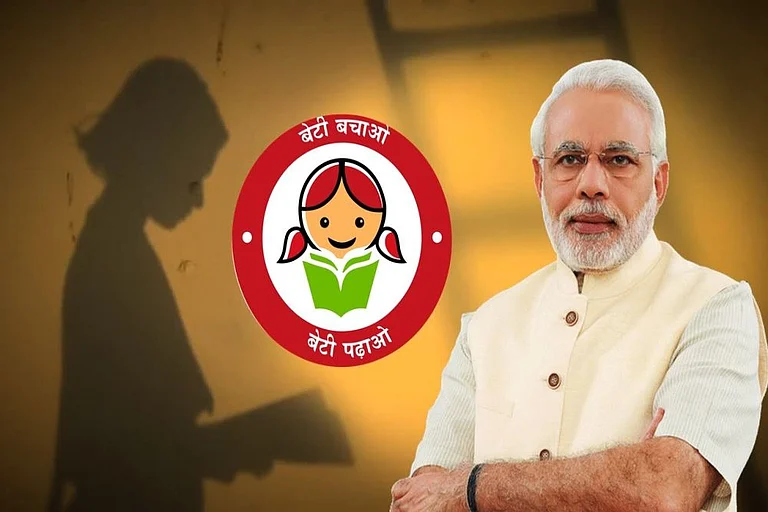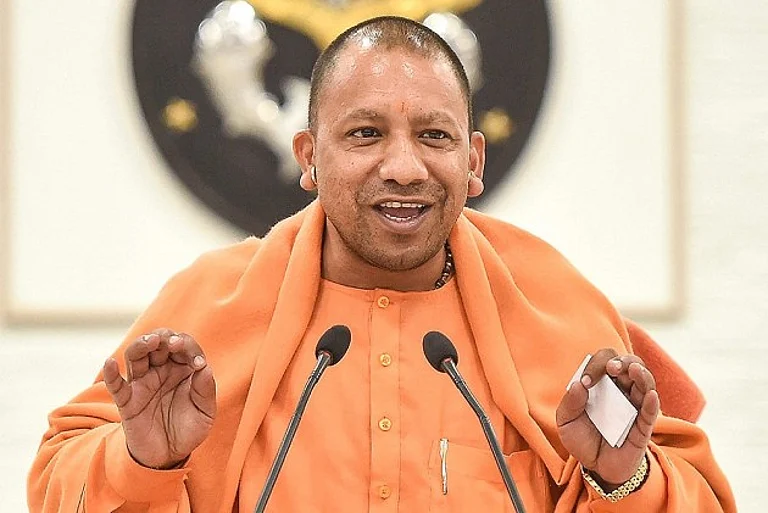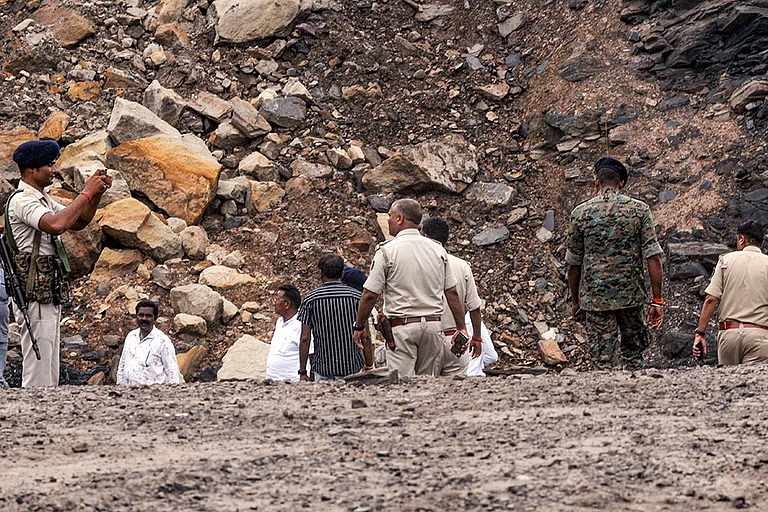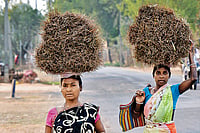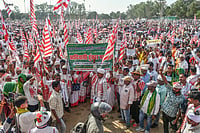Usharani Sardar is thirteen, but she speaks about her constitutional and legal rights with the clarity of a seventy-three-year-old. She asserts her right to an equal share in the family property, saying, “This right is given to me by the law and the Constitution of India.”
Every girl in the village of Tiring is aware of this right. When I arrive in this tribal village, it is four in the evening. The menfolk are returning from their day of wage labour and shopping excursions at the nearby Potka block market, but Usharani's father Chandra Rai Sardar (36) is yet to come home. As we stand reading the nameplate fixed to the frame of their door, Usharani and her mother Chandni Sardar (30) appear from inside their home. Usharani says, pointing to the nameplate, “The name on top is mine and the one below is mother’s. My name has been here since I was five. It has taught me about my right to property. It has given me strength. I will take my equal share in the family property and my mother and father will give it to me.”
Tiring lies in the Kolhan division, about 150 kilometres from the state capital Ranchi and 30 kilometres from the East Singhbhum district headquarters of Jamshedpur. The walls of the tile-roofed homes are painted yellow, red and blue, and they are aglow with the soft light of the setting sun. But gleaming brighter than these walls are the nameplates fitted outside every house.
Usharani's father is a farmer and her elder brother Gurucharan Sardar (15) is a student of class 10. Neither of them have their names on the nameplate. Chandni explains their thinking behind this: “I have to boost my daughter's morale. We do not treat our son and daughter differently. The daughter has the same rights as the son. My in-laws gave a share to their daughter. We will tell Usha that when she goes to her in-laws' house, she too should encourage them to give their daughter her share. If this happens, daughters in every household will get their share.”
Tiring has more than a hundred tribal houses with nameplates. Each one of them states the name of the daughter(s) on top, followed by that of the mother.
Interestingly, this nameplate initiative is not part of any government scheme or campaign, but began, in fact, in August 2016, through the efforts of the then East Singhbhum District Liaison Officer Sanjay Kumar. The unique drive launched by him would go on to become the identity of the village. But before getting into the whys and wherefores of the initiative, let us know the impact that the nameplates have had on the village.
At a T-point in the village, two hundred metres from Usharani's house, Pooja Sardar (13), Kalpana Sardar (12), Muskaan Sardar (12), and Sonamani Sardar (30) are standing in a line. They belong to different families and their names, recorded on the nameplates, are now part of the identity of their homes.
Sonamani, the oldest of them, operates a ration shop out of her home when she is not working to meet the other needs of the household. She says that she does not experience any discrimination between her elder brother Dhanpati Sardar (35) and herself. Similarly, her son and daughter are treated on a par.
According to Sonamani, this sense of equality is experienced by all the daughters in Tiring. The women were already aware of their rights, but their awareness grew further after the installation of the nameplates.
The nameplates are topped by the slogan “Meri Beti, Meri Pehchaan” (My Daughter, My Identity). Pointing towards this slogan, Sonamani tells Outlook, “See, now my mother declares with pride that her daughter is her identity. My house is known as mera [mine]. My house is now known by my name. This makes both my mother and me very proud. Earlier, the daughters did not get a share in the village. Now we get it.”
Sonamani's father passed away when she was young. Her brother Dhanpati Sardar (35) is married and works as a wage labourer. It is Sonamani who fulfils the needs of their mother Danchi Sardar.
Officer Sanjay Kumar is pleased that the nameplates installed by him in the village are still intact and have contributed to the awareness and empowerment of the women living in the village.
He tells Outlook, “It emerged from some surveys that Tiring had a low sex ratio and literacy rate. The people knew the houses and women in the village only by their men's names. She is Suresh's wife, she is Amresh's wife, and so on. This is quite common in our country. I made a small effort to change this mindset. The Government of India had already issued the slogan of Beti Bachao, Beti Padhao [Save the Daughter, Educate the Daughter]. It inspired me to start installing nameplates in the daughters’ names. The villagers helped us a great deal too. We wrote not only the daughters’ names but also the names of the mothers."
Kumar tells us that he also got several streets across the villages of Potka named after the educated girls living there.
Tiring is a village in the Judi Panchayat. According to the 2011 census, the child sex ratio in the village was 768 girls per 1000 boys and the literacy rate among women was only 67 per cent. According to the National Family Health Survey (NFHS-5) 2020-21, the sex ratio in Jharkhand is 948 girls per 1000 boys, which is less than the national average as per the latest census. But in the East Singhbhum district, the sex ratio of the Scheduled Tribes (ST) community is higher than that of the general category. Here there are 1006 ST girls for every 1000 ST boys. The NFHS-5 report also says that there are 1020 women for every 1000 men in the country, but there are more women in rural India than in the cities: for every 1000 men, there are 1037 women in the rural areas, but only 985 women in the cities.
The village head Sukhlal Sardar (32) concurs that Tiring had a problem of skewed sex ratio and low literacy rate, but believes that the discrimination between sons and daughters was a much bigger problem. He tells Outlook, “Earlier, the son would go to school and the daughter would cook food and collect cow dung at home with her mother. The villagers prioritised the education of their sons over that of their daughters. We realised that that mindset and those customs needed to change and that the daughters needed to be respected. So we got together and started installing these plates.”
Sukhlal says that the girls in the village now consider themselves equal to the boys and even outdo them in education. In this, they are encouraged by the nameplates that acknowledge their identity.
Shefali Sardar (21) is one of the girls who have their names on the nameplates. She credits Prime Minister Narendra Modi's Beti Bachao, Beti Padhao campaign for this change. She says that the slogan encourages daughters to go to school. However, Shefali herself was forced to quit school after class 10 due to the financial stress caused by the COVID-19 lockdowns. She hopes she will be able to resume her studies soon.
Manju Sardar (19) and Lakhmani Sardar (18) are pursuing BA and Intermediate studies respectively. They address with great delight people’s queries about their names on the nameplates. These plates have led to people calling them by the names of Manju and Lakhmani instead of their father’s names.
The tribal residents of Tiring belong to the Bhumij tribe, which is an ethnic group of the Mundas. They live mostly in the East Singhbhum district of Jharkhand. They do not practise dowry. When a marriage is to be fixed, the girls never travel out in search of prospective grooms, Rather, the boys visit the villages in search of their brides.
Tarun Kumar, founder of the Nishchay Foundation that works among the children in the tribal villages of East Singhbhum, says that there is no such thing as discrimination between boys and girls in the tribal community, but the patriarchal social system definitely becomes a hindrance in the path of women's progress. He tells Outlook, “The houses in Tiring are identified by the names of their daughters. This initiative, which has been going on in the village for the last eight years, is an example for the entire country. Besides, through various awareness campaigns, the girls and women of the village are also getting useful information related to health, education and gender, which makes them aware, alert, and empowered about their rights.”
According to Sanjay Kumar, the pioneering official, similar initiatives have been adopted in villages of other states as well. On May 1, 2023, nameplates bearing the names of women as well as men were installed outside the homes of the Sasewadi village in Pune, Maharashtra, with the aim of promoting women’s empowerment, media reports said.
At the same time, despite setting a positive example for the rest of the country to follow, the village of Tiring still goes without a number of government-sponsored schemes and facilities. For instance, the benefits of the Pradhan Mantri Awas Yojana and the state’s Abua Awas Yojana have not reached any of its residents. On paper, potable water has reached every house under the Har Ghar Nal Se Jal scheme (meant to supply tap water to every household); in reality, only the pipeline has been laid so far.
The village head says that a list for housing has been prepared and efforts are on to implement the other schemes as well.
The Government of India’s Beti Bachao, Beti Padhao scheme for women empowerment completed nine years in January. Yet, lakhs of girls continue to be killed before or after birth each year. The United Nations Population Fund Report states that there are 45.8 million missing females in India as of 2020. These are female foeti or infants who were detected and killed before or after their birth.
Translated by Kaushika Draavid








